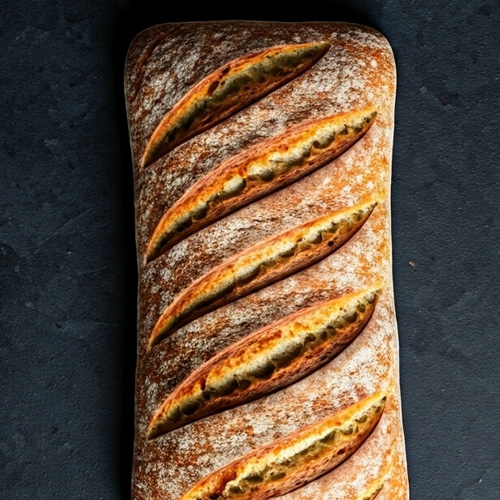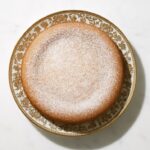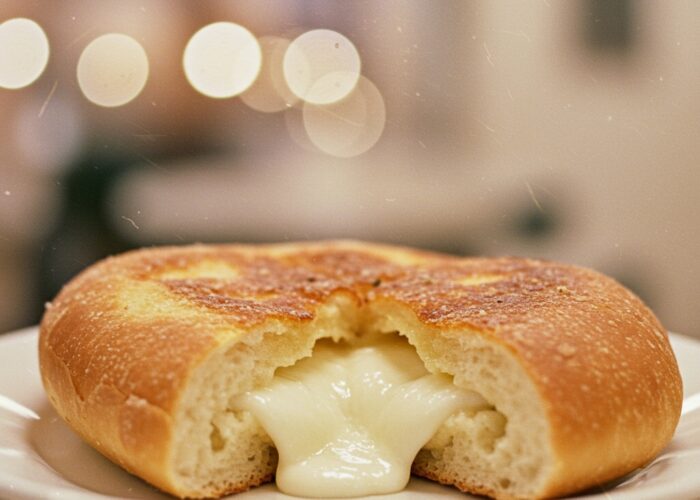Ciabatta Bread: A Light, Crispy Italian Classic
Ciabatta bread is a relatively new addition to Italy’s long baking tradition. It was first created in 1982 by baker Arnaldo Cavallari in the Veneto region. Inspired by the rising popularity of French baguettes, Cavallari wanted to offer Italians a lighter bread ideal for sandwiches. The result was ciabatta, which means “slipper” in Italian—a nod to its flat, elongated shape.
What makes ciabatta unique is its wet, high-hydration dough. This gives the bread its signature crispy crust and light, airy crumb filled with holes. The texture is chewy yet delicate, making it perfect for paninis or as a side to soups and salads. Since its invention, ciabatta has grown in popularity across Italy and around the world, praised for its rustic feel and incredible versatility.
Sponge
- 1¾ cup bread flour
- 1 cup water (room temperature)
- ¼ tsp instant yeast
Dough
- 2¼ cups bread flour
- 1 cup water (room temperature)
- ½ tsp instant yeast
- 2 tsp salt
Sponge
Combine the flour, water, and yeast in a medium bowl. Stir using a wooden spoon until the mixture is thoroughly blended and reaches a smooth consistency. Cover the bowl with plastic wrap and allow it to ferment at room temperature for a minimum of 12 hours, extending up to 20 hours.
Dough
Introduce the sponge and all the dough ingredients into the bowl of a stand mixer, equipped with the paddle attachment. Operate the mixer on low speed to ensure all the flour becomes moistened, which typically takes around 2-3 minutes. Then, elevate the speed to medium-low and continue mixing until the dough coalesces into a cohesive mass, detaching from the sides of the bowl.
Transition to the dough hook attachment and adjust the mixer to medium-low speed. Allow the mixer to run until the dough transforms into a smooth and glossy texture, around 10 -12 minutes. The resulting dough should be soft, moist, and sticky, akin to a batter-like consistency.
Gently apply a thin layer of olive oil to the interior of a spacious bowl. Employ a spatula to transfer the dough into the bowl. Cover the bowl with plastic wrap and allow the dough to rise for a duration of 1 hour at room temperature.
Using a spatula or damp hand, delicately grasp one side of the dough and lift it, then gently stretch it over the top of the dough itself. Rotate the bowl by 180 degrees and repeat the stretching process. Turn the bowl by 90 degrees, perform another stretch and fold action. Finally, turn the bowl by 180 degrees once again to complete the stretch and fold on the last side. Flip the dough so that the previously bottom side now faces upwards. Cover the dough with plastic wrap and allow it to rest at room temperature for a duration of 45 minutes.Repeat the folding process two more times, each time covering the dough with plastic wrap and letting it rest for an additional 45 minutes afterward. Preheat the oven to 450°F (232°C). It's crucial to allow the oven to preheat for a minimum of 30 minutes to ensure it reaches the required high temperature.
Arrange the oven racks, ensuring one is positioned in the lower-third part and the other at the absolute bottom position. Set a cast-iron skillet on the lowest rack.
Sprinkle some flour over your work surface and carefully release the dough from the bowl onto it. Exercise gentleness in this step to avoid deflating the dough and aim to minimize handling. Generously sprinkle flour over the top of the dough. Utilizing two bench scrapers that have been floured, gently shape the dough from its sides, coaxing it into a square form. Take care to avoid applying pressure on the top surface of the dough.
Divide the dough in half by slicing down the middle of the square. With the help of the bench scrapers, gently mold each half into loaf shapes by working with the sides.Turn over a sizable baking sheet and position a sheet of parchment paper over it. Dust the parchment paper generously with flour. Utilizing both bench scrapers, slip them beneath both ends of the dough and relocate the dough to the parchment paper you've prepared. Repeat this process with the remaining loaf. While shaping the dough into rectangles, use your fingertips to gently press the surface of each loaf. Place a cloth over the loaves and allow them to proof in a location free from drafts. This should continue until they become puffy and the surface exhibits small bubbles, which usually takes around 30 minutes.Keep a cup filled with 1 cup of ice prepared. Mist the loaves with water and then gently glide the baking sheet into the oven. Swiftly place the ice into the cast-iron pan positioned on the lower rack. Promptly shut the oven door. Bake the loaves until the crust achieves a deep golden-brown hue, which typically takes around 25 to 30 minutes. Once done, transfer the loaves to a cooling rack and allow them to cool completely before serving.
Bread Flour Works Best: opt for bread flour instead of all-purpose flour. Its higher protein content helps develop the gluten needed for ciabatta’s chewy structure.
Time to Rise: Long fermentation is key. Let the dough rise slowly to build flavor and allow those beautiful air pockets to form. Some bakers even prefer an overnight cold rise in the fridge.
Use Stretch and Fold Method: Traditional kneading isn’t necessary. Instead, use the “stretch and fold” technique during the first rise to strengthen the dough without overworking it.
Handle Gently: After the final proof, be careful not to deflate the dough. Gently shape it on a floured surface and avoid pressing out the air bubbles.
Bake on a Hot Surface: For the crispiest crust, bake your ciabatta on a preheated baking stone or steel. Adding steam to the oven (by placing a pan of hot water inside) can help enhance the crust even more.
Let It Cool Completely: As tempting as it is to slice in right away, let the bread cool fully. This helps the crumb set and keeps the texture light and airy.
Focaccia Bread Is Loved Around the World
These days, focaccia is loved all around the globe. Whether it’s adorned with fresh herbs, roasted veggies, olives, or even melted cheese, this bread is so much more than just a side dish. It’s a delicious piece of Italy’s culinary heritage, reminding us all of the simple joys that come with homemade food.
Serving Ciabatta Bread
Ciabatta’s light, airy crumb and crisp crust make it one of the most versatile breads to serve. Whether you’re building a hearty sandwich or setting the table for a cozy dinner, here are some tasty ways to enjoy it:
Classic Paninis: Ciabatta is the go-to bread for paninis. Slice it horizontally, fill it with cheese, meats, and veggies, then press and grill for a golden, melty masterpiece.
Dipping in Olive Oil: For a simple appetizer, serve warm ciabatta with extra virgin olive oil, balsamic vinegar, and a sprinkle of sea salt or herbs.
Soups and Stews: The chewy texture is perfect for dipping into tomato soup, minestrone, or hearty beef stew. It holds its shape without getting soggy too quickly.
Bruschetta or Crostini: Toast slices of ciabatta and top with diced tomatoes, garlic, basil, or any of your favorite bruschetta toppings.
Breakfast or Brunch: Try it toasted with butter and jam, or use it as the base for avocado toast or open-faced breakfast sandwiches.
Charcuterie Boards: Cut into small slices and serve alongside cheeses, cured meats, olives, and spreads for a rustic touch to your board.
Storage
Ciabatta is best enjoyed fresh, but with the right storage methods, you can extend its life without sacrificing too much texture or flavor. Here’s how to keep your ciabatta tasting great:
Room Temperature: Wrap the bread in a clean kitchen towel or paper bag and store it at room temperature. This helps maintain the crust while preventing it from drying out too quickly. (up to 1–2 Days)
Avoid Plastic Bags: Plastic traps moisture and makes the crust soggy. If you must use plastic, add a paper towel inside to absorb excess moisture.
Freezing: Freeze While Fresh: For longer storage, freeze your ciabatta on the day it’s baked. Slice it first if you plan to use it for sandwiches or toast.
Wrap It Right: Wrap the loaf (or slices) tightly in plastic wrap or foil, then place it in a freezer-safe bag. Label with the date. (up to 3 months)
To Reheat: Thaw at room temperature, then warm in the oven at 350°F (175°C) for about 5–10 minutes to revive the crust.
Don’t Refrigerate: Refrigeration dries out bread quickly and can ruin the texture, even if it seems like a good idea. Always freeze instead if storing longer than two days.
Like this:
Like Loading...













